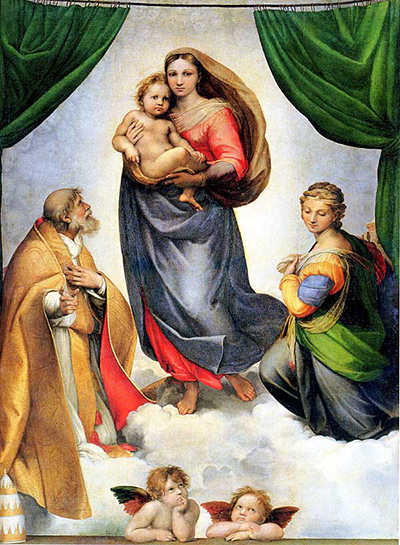One of the last Madonnas Raphael painted was The Sistine Madonna circa 1514.
The Sistine Madonna was commissioned by Pope Julius II in 1512 for San Sisto Piacenza, a Roman Catholic church in Piacenza, Italy. It held its place as an altarpiece in the church for many years before being sold in 1754 to Poland's king at the time, Augustus III, by the Benedictines for twelve thousand zecchini or around 110,000 francs, which would have been a significant amount.
The painting was brought to Dresden, Germany where its prominence increased dramatically. Apparently, King Augustus III moved his throne in order to provide a better view of the painting because it was considered to be immensely religious. Over the years, it became a popular legend that the painting itself could cause viewers to feel religious ecstasy.
Some even believed Raphael received a divine message or vision telling him to paint this masterpiece, making it a significant painting during the German Renaissance in the 1800s (see Albrecht Durer's paintings). The Sistine Madonna was even influential to significant figures such as Dostoyevsky, Neitzsche, Goethe, and Wagner.
This oil on canvas painting is immense in size at 265 cm by 196 cm. Raphael depicts the Madonna figure holding the Christ Child with the female figure being Saint Barbara and the male, Saint Sixtus.
There are many indistinct cherub faces among the clouds in the background while two cherubs can be seen at the bottom. These cherubs are actually quite famous as they are often depicted by themselves. Apparently inspired by children Raphael knew, they can be found on wrapping paper, postcards and stamps. Fortunately, the painting was rescued during the bombing of Dresden in the Second World War.
Afterwards, it spent some time in Moscow only to be returned to Germany after the death of Joseph Stalin. The acquisition of the painting by the Soviets was a point of controversy between the two nations so it was returned to ease this strife. Today, Raphael's The Sistine Madonna is part of the collection at the Gemaldegalerie Alte Meister in Dresden. It is considered to be one of the most famous paintings in the collection and a highlight worth seeing.
Raphael was a famous Italian painter and architect as well as one of the leaders of the Italian High Renaissance. Heavily influenced by Leonardo da Vinci, Michelangelo and Fra Bartolommeo, Raphael was able to create his own artistic style.
He passed away at the young age of thirty-seven but nevertheless had a successful career and left a significant legacy. While he may be best known for his works completed for the Vatican, the series of Madonnas he painted are also very notable.




